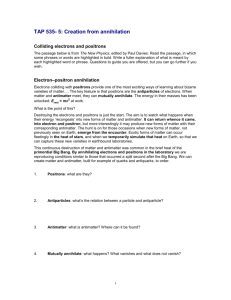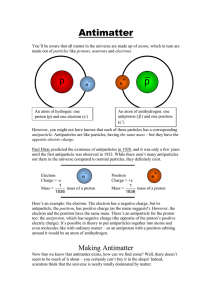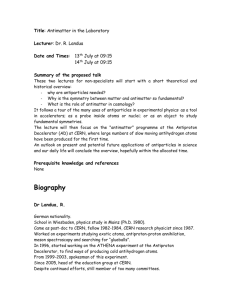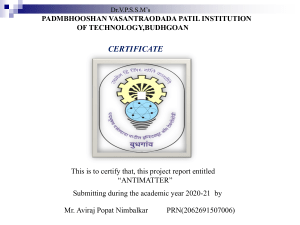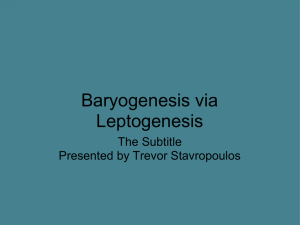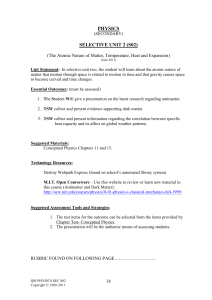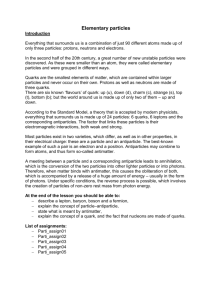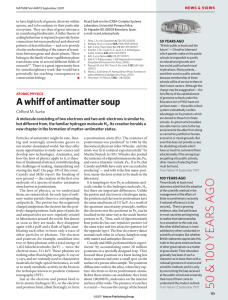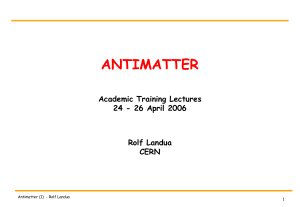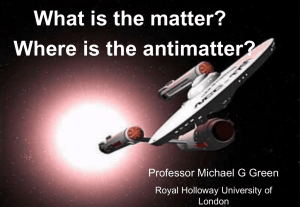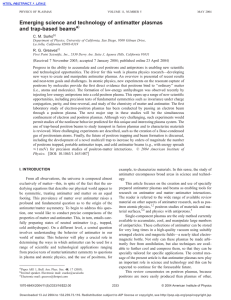ANtimatter - University of Manchester
advertisement
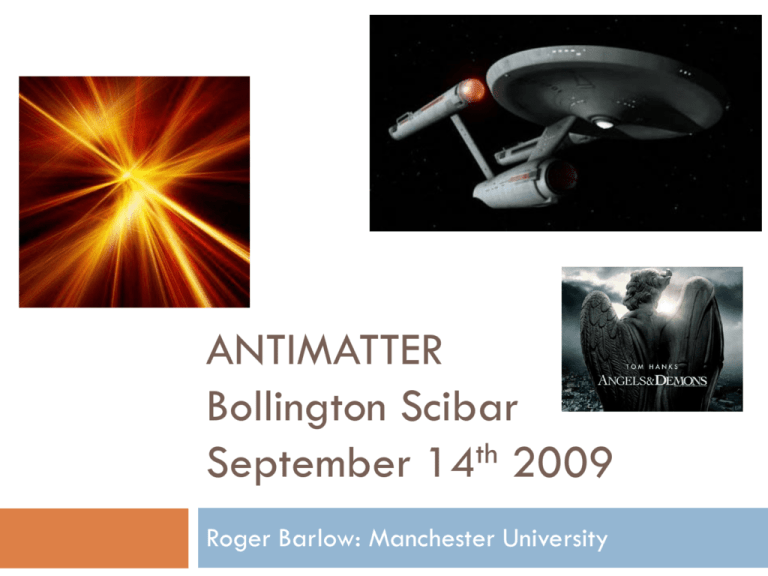
ANTIMATTER Bollington Scibar September 14th 2009 Roger Barlow: Manchester University Matter – the electron Discovered over 100 years ago An everyday object – electronics, electricity, atomic physics… Still one of the fundamental ‘elementary particles’ Properties known very well: Mass 9.109382… 10-13 kg Charge -1.6021765… 10-19C Radius Zero (?) e Paul Dirac (1902-1984) Dirac Equation ihc . mc E 2 Deduced from aesthetics. Explains the magnetic behaviour of the electron and links it to its electrical behaviour But ….. Dirac’s “unwanted” answers The equation always gives two solutions. - Sensible solution. With positive energy. E.g. E=½mv2 - Crazy solution. With negative energy. E.g. E=-½mv2 Basically it gives E2. Which has positive and negative roots. What next? 1. Reject the equation 2. Ignore crazy solutions 3. Take them seriously 3) Take them seriously. Think it through… + charged - charged Ordinary electron travelling left to right Attracted by the + plate, repelled by the - plate Picks up energy. E=½mv2 Goes faster. “Crazy” electron travelling left to right Picks up energy. E= -½mv2 Goes slower Behaves as if it were repelled by the + plate attracted by the – plate Battery It’s always the same ‘Negative energy’ electrons behave like ordinary electrons with the opposite charge: plus instead of minus. Another particle (or just another aspect of the basic particle) The Positron or Anti-electron Mass 9.109382 10-13 kg Charge +1.6021765 10-19C Radius Zero (?) Properties exactly the same (or exactly opposite) Plenty of positrons High energy photons (MeVγrays) produce electrons and positrons in pairs. Lots in cosmic ray showers Some nuclei βdecay by emitting a positron 22Na 22Ne + e++ ν Also 11C, 13N, 15O, 18F Half lives of minutes What about other particles? protons, neutrons, quarks … Yes, they all have their antiparticle equivalents: Antiprotons, antineutrons, antiquarks… Often denoted by a line (bar) above: p Experiment to study B and B particles All properties exactly the same or exactly opposite (But only antielectrons have their own special name) Matter meets antimatter If a particle meets its antiparticle: Total charge (etc) is 0 Combine to give lots of lower-mass particles, typically gamma rays (‘annihilation’) Isn’t that dangerous? 1 gm of antimatter + 1 gm matter 2mc2=1.8 1014J (A days output for a large power station) But to make that gram you need – many days output from a large power station Another question Why is the universe full of matter and empty of antimatter? If positrons and electrons are equal, why aren’t there equal numbers of both around? (Just as well!) Equal numbers of particles and antiparticles An imbalance develops, ~1000000001 particles to 999999999 antiparticles Most particles annihilate with antiparticles leaving the residue What was that difference? We don’t know! This is one of the big 3 questions of particle physics There are small differences in the behaviour of Kaons. A K0 will decay to e+π - or to e- π + . The rates are slightly different (0.3%). So e+ and e- do differ a little Explained by Kobayashi and Maskawa Their theory also predicts similar effects with B particles Predictions spot on – Nobel prize for K & M These are not big enough to account for the matter/antimatter domination. Antimatter Part of our understanding of the universe But we still don’t understand everything Frequently Asked Questions Are there antiphotons? No. Or rather: the antiphoton is exactly the same as the photon so there isn’t a separate species. What about antineutrons? Antineutrinos? Yes. Although these are neutral so their antiparticles have the same charge (0=0) they have other properties which are different. Do antiparticles mean antigravity? No. Apples and antiapples both fall downwards Could distant galaxies be made of antimatter? No. Though they would look just the same. But the space where galaxies meet would produce lots of annihilation radiation Does antimatter have any use? Yes. PET scanners – Positron Emission Tomography What about anti-antiparticles? These are the original particles Positrons at work: PET scanning Positron Emission Tomography Prepare biologically interesting chemical with positron emitting nucleus (e.g. FDG – like glucose) Inject patient. Molecules move to sites where needed Nucleus decays giving positron Positron encounters electron and ‘annihilates’ to 2 photons, emitted back to back Photons are detected externally. The decay ocurred somewhere along the line joining them Collect more data and get 3D map From antiparticles to Antimatter Hydrogen P e Antihydrogen P e Straightforward to make: Make antiprotons. (1M protons at 1 GeV give ~25 antiprotons) Make positrons. (easier). Combine them. Worth studying to see if properties really are the same as Hydrogen Very hard/impossible to store
